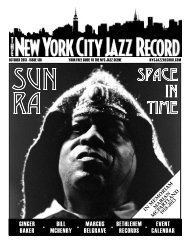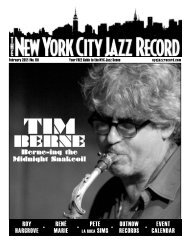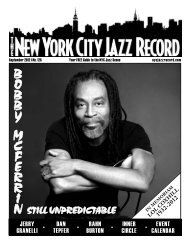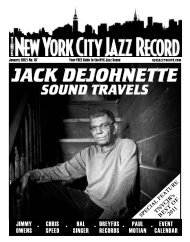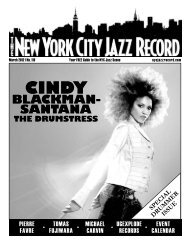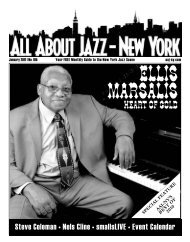Return of the Guitar Man - The New York City Jazz Record
Return of the Guitar Man - The New York City Jazz Record
Return of the Guitar Man - The New York City Jazz Record
You also want an ePaper? Increase the reach of your titles
YUMPU automatically turns print PDFs into web optimized ePapers that Google loves.
NEW YORK @ NIGHT<br />
4 October 2011 | THE NEW YORK CITY JAZZ RECORD<br />
Photo by Jim Anness<br />
<strong>Guitar</strong>ist Michael Pisaro’s “Ascending Series (6)” on<br />
Sep. 13th marked a sort <strong>of</strong> an end for two weeks at <strong>The</strong><br />
Stone curated by Erstwhile <strong>Record</strong>s as well as a prelude<br />
for <strong>the</strong> two-day Gravity Wave Festival, which featured<br />
his quiet compositions and capped <strong>the</strong> run. <strong>The</strong> piece<br />
- an exercise in silence and tonality in just under 40<br />
minutes - was written for and played in duet with<br />
trombonist Radu Malfatti, ano<strong>the</strong>r devotee <strong>of</strong> stillness<br />
in music. Each <strong>of</strong> <strong>the</strong> musicians was armed with a<br />
timer, which kept <strong>the</strong>m both in silence for <strong>the</strong> first<br />
several minutes before Pisaro initiated a low drone<br />
with Ebow and electric guitar, matched in short order<br />
by a much higher tone (seemingly generated by<br />
Pisaro’s laptop), <strong>the</strong>n ano<strong>the</strong>r extended low tone from<br />
Malfatti’s horn. All <strong>of</strong> this came <strong>of</strong>f like a tableau<br />
against ano<strong>the</strong>r ra<strong>the</strong>r appealing sound, which may<br />
have come from <strong>the</strong> computer or perhaps water in <strong>the</strong><br />
pipes overhead. Three distinct tone fields - trombone<br />
(low), guitar (low or high) and electronics (high), <strong>the</strong><br />
absence <strong>of</strong> sound perhaps being a dominant fourth -<br />
seemed to work in strict but independent time<br />
intervals. <strong>The</strong> elements were so few that it began to<br />
feel like an unevenly measured round, each <strong>of</strong> <strong>the</strong> three<br />
voices cycling in and out (variations within <strong>the</strong>m were<br />
few; occasional quick notes in <strong>the</strong> upper register were<br />
<strong>the</strong> greatest alteration), sometimes occurring<br />
concurrently. But even with <strong>the</strong> silence, <strong>the</strong>re was<br />
always <strong>the</strong> feeling <strong>of</strong> method, <strong>of</strong> a process at work.<br />
- Kurt Gottschalk<br />
Michael Pisaro & Radu Malfatti @ <strong>The</strong> Stone<br />
Despite having played in duo only once before - a set<br />
<strong>of</strong> less than 15 minutes some 10 years ago - <strong>the</strong> pairing<br />
<strong>of</strong> saxophonist John Butcher and syn<strong>the</strong>sizer player<br />
Thomas Lehn at Issue Project Room Sep. 20th was a<br />
natural. <strong>The</strong> two, <strong>of</strong> course, have played toge<strong>the</strong>r in<br />
o<strong>the</strong>r situations, most notably <strong>the</strong> trio <strong>The</strong>rmal with<br />
guitarist Andy Moor <strong>of</strong> Dutch ‘rock group’ <strong>The</strong> Ex.<br />
With <strong>the</strong> brash sound <strong>of</strong> <strong>the</strong> saxophone, it was tempting<br />
to hear <strong>the</strong>m as a duo <strong>of</strong> some sort or ano<strong>the</strong>r: sax and<br />
organ, sax and drums. But it proved easier - or at least<br />
more economical - to give up on <strong>the</strong> idea <strong>of</strong> <strong>the</strong> horn<br />
altoge<strong>the</strong>r. Butcher’s sax is his laboratory, <strong>the</strong> science<br />
<strong>of</strong> air pushed through tubes his area <strong>of</strong> expertise.<br />
Playing alternately unamplified, into a microphone<br />
running through a volume pedal or a second mic<br />
boosted to feedback levels, Butcher had access to <strong>the</strong><br />
whole dynamic range <strong>of</strong> <strong>the</strong> horn. Lehn, meanwhile,<br />
was unusually understated for <strong>the</strong> first half <strong>of</strong> <strong>the</strong> set,<br />
letting s<strong>of</strong>t waves emanate from his syn<strong>the</strong>sizer and<br />
slowly build. <strong>The</strong> analog electronics rig is fantastically<br />
malleable in his hands: <strong>the</strong> pair <strong>of</strong> decks, one altered<br />
and bent with a circuitry card, proved capable <strong>of</strong> great<br />
and sometimes excitingly propulsive sounds. When<br />
Butcher switched to soprano, <strong>the</strong> energy was upped,<br />
both becoming more percussive. So was it a drum duo<br />
perhaps? By <strong>the</strong> time Butcher was playing his<br />
mouthpiece with <strong>the</strong> flickering <strong>of</strong> fingers <strong>the</strong>re was<br />
little difference between sax, synth and drums anyway.<br />
(KG)<br />
Danish multi-saxist Lotte Anker has been working<br />
with pianist Craig Taborn and drummer Gerald<br />
Cleaver since 2003, with two recordings under <strong>the</strong>ir<br />
collective belts. <strong>The</strong> trio musically reacquainted<br />
<strong>the</strong>mselves at Barbès (Sep. 7th), launching a mini-tour<br />
to include <strong>the</strong> Guelph Festival on 9/11-eve. Anker<br />
started on soprano sax with a throaty tone <strong>of</strong> shaking<br />
vibrato and stuttered attacks, gradually bringing her<br />
sound forward to a full boisterous resonance, moving<br />
to alto mid-piece and ending <strong>the</strong> set on tenor. Cleaver<br />
followed a similar arc, at first showing his mastery <strong>of</strong><br />
<strong>the</strong> understatement, playing barehanded or grabbing<br />
for an unusual assortment <strong>of</strong> sticking implements<br />
(baby rattle, telephone cord, sleighbells) and<br />
‘preparing’ his kit in various ways to produce a<br />
panoply <strong>of</strong> percussive textures, eventually building to<br />
a rock-solid ten-beat pattern that pulsed with an avantmeets-Motown<br />
sound. Taborn, <strong>the</strong> third ‘leg’ <strong>of</strong> <strong>the</strong><br />
improvising triangle can, like Anker and Cleaver, be<br />
sparse and spare when <strong>the</strong> musical environment calls<br />
for it, or let loose with both shotgun barrels when so<br />
inspired. In many places his musical commentary was<br />
merely implied or insinuated, but elsewhere his<br />
energetic fusillades <strong>of</strong> two-handed passages decorated<br />
with jagged ornaments filled every corner <strong>of</strong> <strong>the</strong> room.<br />
<strong>The</strong> drums and bass played powerful hits toge<strong>the</strong>r and<br />
<strong>the</strong> group came to a vibrant climax just before ending<br />
<strong>the</strong> first piece and again during a shorter ‘encore’.<br />
- Tom Greenland<br />
Cleaver/Anker/Taborn @ Barbès<br />
On Sep. 9th, <strong>The</strong> Kitchen, a four-decade bastion <strong>of</strong><br />
experimental improv, began “Pioneers <strong>of</strong> <strong>the</strong><br />
Downtown Sound”, a mini-series curated by Rhys<br />
Chatham to revisit and update its early years. Chatham,<br />
most known for No Wave “guitarchestras”, opened<br />
with solo cornet filtered through three channels <strong>of</strong><br />
digital delays in long-decaying overlapped loops,<br />
building on a single pinched note, gradually adding<br />
tones above and below, false-fingered trills and<br />
squelched burps to construct a gurgling swirl <strong>of</strong> sound,<br />
ending <strong>the</strong> minimalistic conconction on his knees, as if<br />
in prayer, hands stretched forward to <strong>the</strong> fader knobs.<br />
Joan La Barbara sang an etude <strong>of</strong> descending<br />
exhalations immediately alternated with ascending<br />
inhalations, accelerating and expanding each cycle,<br />
adding multiphonics, <strong>the</strong>n reversing direction to<br />
reprise her opening gesture. “Twelvesong” featured<br />
live-dubbed vocalizations (cat and bird calls, ripping<br />
cloth, radio static, creaking doors, etc.) over a<br />
pre-taped mix, like a Foley artist making an imaginary<br />
movie soundtrack, capped by a spontaneous a cappella<br />
piece. Pauline Oliveros ‘un-conducted’ <strong>the</strong> audience<br />
in participatory vocal performance, <strong>the</strong>n unveiled a<br />
MIDI-controlled button accordion, triggering acoustic<br />
bass, voice and brass samples in uncanny juxtaposition,<br />
dramatically articulated, finally inviting Chatham<br />
back onstage for a duet, his farted howling timbres<br />
panning over and behind her muted brass and clarinet<br />
patches. (TG)<br />
Photo by Scott Friedlander



